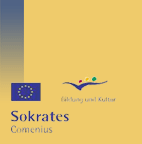Testing
the project "box village" (developed in the Netherlands) in
institutions of elementary education in Germany.
The project "box village" developed in the Hague was put into
practice and tested in day-care institutions:
In the process it became clear that pre-schoolers were mostly interested
in building individual houses. At first, the construction of a walkable house
of their own was what interested them most. It was only later that the aspect
of building a village gained weight and significance for the children, and they
then focussed on individual objects that they were well acquainted with, like a
police station and a post office. Other social aspects were less interesting
for the children.
During the development and the production of the individual houses,
phases of building and playful use constantly alternated. Many ideas were
conceived during play phases. A differentiated equipment of the individual
houses and rooms was particularly important for the children: mirrors,
washbasins, furniture, bells, lamps etc. had to be added. Younger children took
to painting and wallpapering the houses and gladly lent the older ones a hand,
while the older children were more interested in the technical equipment. Boys
and girls basically showed the same interests, the girls found an aesthetic
design especially important. All children thought that the long-term durability
of the houses was particularly important.
It became obvious that children learn about scientific and technical
contents predominantly by experience and by actively exploring and discovering
phenomena. They rather explore individual scientific phenomena than gain
complex and coherent insights.
During the entire building phase the children were very motivated and
acquired important abilities, such as: treating each other with care, being
mutually considerate and helpful, differentiated perception and observation of
their environment, conversion of their observations into their own activities
and constructions, acquisition of concrete new skills (e.g. handling a
measuring stick), reflection of questions concerning housing (e.g. debate on
energy consumption), acquisition of physical and technical knowledge.
Finally we would like to point out that during the project the
individual situation and interest of the respective group of children should be
considered. The box village requires a lot of space. If enough space is not
available it might as well be interesting to build doll's houses with the
children.
If you want to put this project into practice, it makes sense to get
competent parents and adults involved and to organize excursions to specialist
shops.
Part 1: Planning phase
Part 2: Construction
Part 3: Finishing
the interior of the houses
Part 4: Electrification
of the houses
Part 5: Water supply
Video: Download (20,7 MB)











